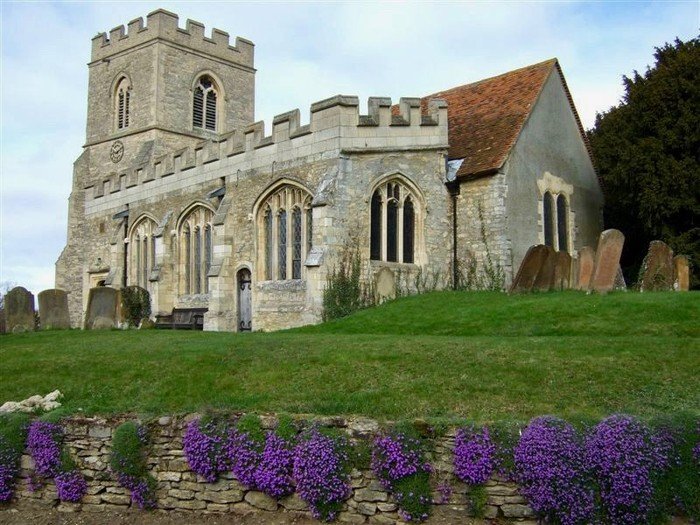All Saints’ Church, Loughton
All Saints' is a 13th century church which has been extended over the centuries. It has a lovely stone floor (with underfloor heating!) and modern chairs which can be arranged in different layouts for services and events.
It's one of two churches in the partnership with an active bell tower and the six bells are rung by a team of bell ringers for weddings and special events throughout the year.
If you would like more information please contact us.
If you would like to hire the building please click here.
Church Lane, Loughton, Milton Keynes MK5 8AS
Sunday Services
8:00am - a Holy Communion service using the Book of Common Prayer
10:00am - an informal family service
- Family Communion on 2nd & 4th Sundays
- Refreshments are served after the 10am service
See calendar for full details.
What's on at All Saints'
Follow us at All Saints' on Facebook!
History and major features of All Saints
History and major features of All Saints’
Date: September 29, 2017
Author: Derek
Updated: May 2, 2020
Author: Gary
This guide gives you a little of the history of the medieval building of All Saints' Church, Loughton.
The church has looked as it does today since 1480, but parts of the building go back to the 13th. century. At that time there were two manors and two parishes; Great Loughton, around the present church and Little Loughton, around the Green, the two being separated by the Brook. Each parish had its own church and rector. One of Loughton's claims to fame is that in 1378 John Gervyes, Priest of Great Loughton, was found guilty of killing the parson of Little Loughton with an arrow. In 1408 the parishes of Little and Great Loughton were united, and the south aisle of this church is reputed to have been built of stone from the other church.
All Saints' Church is the oldest building in Loughton, and stands on what is probably an artificial mound. The oldest part of the church is the Chancel, at the East End; the original walls date from the 13th. century. In the early 15th. century the Nave was added, with the half-columns supporting the Tower arch. ('The shape of the windows near the tower, and behind the altar, has been altered over the years). To this modest structure was added, in the 1480s, the fine perpendicular South Aisle with its splendid moulded roof and crenellated parapet, and a new west tower with west door and window. The tower is 46ft. high and houses seven bells and a clock.
The church was restored around 1826, and again by E.S. Harris between 1877 and 1883. Internally, box pews were replaced by bench pews in Victorian times. A major refurbishment of the tower was carried out in 1984. In 1990 the south aisle and porch were restored and the bracing rods fitted; at the same time work to combat damp in the north-east corner of the nave resulted in the discovery of a hidden stairway.
In 2010 the crumbling brick and wooden floor was replaced by a new stone one, and the pews were replaced by chairs, providing a flexible space within the church. During this work, a previously unknown vault was discovered in the nave, containing the coffins of three members of the Smith family from the mid 19th Century. A slab in the new floor marks the position of this vault.
In 2018 the bells were restored. They were rehung all at the same level in a new galvanised steel frame with new fittings, the poorly-toned treble was recast, and the out-of-tune tenor was replaced with a new bell. The old tenor is now used as the clock bell. At the same time other much needed work in the bell tower was carried out including repairs to the roof, restoration of the Royal Coat of Arms which was hanging on the wall of the ringing room, and repairs to the stone staircase leading up to the bells.
In 2019 the oak screen which separated the ringing chamber from the nave was replaced with a glass screen with sliding doors. The glass screen lets in light from the west window into the main body of the church, and was positioned so as to provide more space in the ringing chamber.
In the Southwest Corner of the Churchyard there is an interesting grave stone with inscriptions on both sides. It is to Captain David Smith, one of six officers who in 1809, after the battle of Corunna, stood by the grave of Sir John Moore when, as told in the poem by C. Wolfe: 'Not a drum was heard, not a funeral note, As his corpse to the rampart we hurried. Slowly and sadly we laid him down From the field of his fame fresh and gory; We carved not a line and we raised not a stone But we left him alone with his glory.'
Other features at All Saints' include:
(a) The Royal Coat of Arms above the main door to the church dates to William IV (1831). During his reign all churches had to display the arms in support of the king. These arms show the shield of Hanover; this was abandoned in 1837 as the then Queen Victoria, under Salic Law, could not inherit German titles. The painting was restored in 2018.
(b) The Hanslap Family Memorial. Before selling his manor to Ralf Holt, John Crane conveyed his lands in Loughton to Edward Alston, whose son sold them to Thomas Hanslap, about 1699. Hanslap sold an estate in Aynho, Northants., to purchase Loughton. Thomas Hanslap's son John rebuilt part of the manor house at Little Loughton.
(c) The Parish Chest. This 17th. century iron-bound alms chest has provision for five locks.
(d) The Crane Family Memorials. Two tablets which were presumably erected by John Crane of Loughton; one of 1622 to his mother Felice Mortoft of County Durham, and the other of 1624 to his wife Mary, daughter of Thomas Tresham of Newton, Northants. (cousin of the Sir Thomas Tresham who built the famous triangular lodge at Rushton). In 1613 Little Loughton Manor was sold to John Crane, who later became Chief Clerk of the Green Cloth to Charles II. He and his wife Mary had eleven sons and five daughters, all living in Little Loughton Manor House. In 1657 John Crane was fined by the Interregnum Parliament for supporting the king; this forced him to sell the manor to Ralf Holt, the then Lord of the Manor of Great Loughton. The manors, as had the parishes, merged. John Crane was buried here in 1660, and his son Robert (see also his memorial) in 1672.
(e) The bells are now a ring of six (tenor 11 cwt 2 qtrs). They are hung in a galvanised steel frame, with space for an additional two trebles. Before 1902 there were four bells. These were rehung around 1866 to 1870 by an engineer from Northampton who constructed an elaborate A-frame of sloping timbers. The treble had an iron stay and slider. In 1902 the old treble was recast by Taylors of Loughborough and a new treble added. A further treble was added in 1908 by Alfred Bowell of Ipswich. In 2018 the bells were rehung in a new galvanised steel frame, the treble was recast, the second, third, fourth and fifth bells were tuned, and the tenor was replaced with a new bell cast by the Westley Group. The old tenor is now used as the clock bell. The bells are thus: Treble – Westley Group 2018; 2nd and 3rd - John Taylor 1902; 4th and 5th - William Chamberlain of London circa 1450; Tenor – Westley Group 2018; Clock bell - Bartholomew Atton of Buckingham 1590.
(f) The Tower Arch is of early 14th. century style, supported by 13th. century impost half-columns. The tower was built in the 1480s, but the west door and much of the west window were blocked by a buttress added in the 19th. century.
(g) The Picture of the Supper at Emmaus was restored in 2014 and was originally thought to be by Gonzales, an 18th. century court painter in Madrid, though now we're not certain of this. It was presented by Rev. John Athawes.
(h) The Doorway behind the font was discovered during restoration work in 1990 and gives access to a spiral staircase, presumably to a rood loft. It was decided to reopen the doorway, fit a child-proof gate and to move the pulpit.
(i) The Athawes Family Memorials. These handsome marble memorials commemorate the family which provided Loughton with two rectors. Rev. John Athawes, rector for 31 years, died in 1864, while Rev. John T. Athawes was rector 1883-1915. He is commemorated by the East window of the south aisle, and he appears among the photographs of rectors of the parish which can be seen in the vestry.
(j) The Hugh Park Memorial. Within the communion rails is the half-length brass depicting Hugh Park. He died in 1514, having been made rector in 1485, but the charity that bears his name benefits the church and people of Loughton to this day.

